Category Management Strategies in Pharma Procurement

TL;DR
- Procurement in pharma often fails not due to unclear goals, but because of fragmented systems and reactive processes.
- This blog outlines how category management addresses inefficiencies and brings structure to procurement strategy.
- A step-by-step framework helps teams align spend, improve supplier performance, and enhance patient care delivery.
- Disconnected procurement leads to missed savings and poor supply visibility category strategies solve this with measurable results.
- The problem isn’t too many tools; it’s the lack of a system that connects strategy, execution, and outcomes.
55 % of pharmaceutical firms report severe or substantial supply chain disruptions affecting product delivery.
Procurement in the pharmaceutical sector is complex, fragmented, and under constant regulatory pressure. Supply chain disruptions, increasing treatment costs, and unpredictable demand have made it harder for companies to stay efficient and compliant while still delivering better patient care.
That’s where category management in pharma is proving to be a practical solution.
By treating each group of products like antibiotics, oncology drugs, or medical devices as strategic business units, organizations can drive better outcomes across cost, quality, and availability. This blog breaks down how category management is transforming pharma operations, and how teams can implement it step-by-step to create measurable value.
Why Category Management in Pharma Matters
The pharmaceutical supply chain is interconnected but each stakeholder faces unique challenges. From hospital buyers to patients, fragmented procurement practices lead to rising costs, inefficiencies, and inconsistent care. This is where category management in pharma provides structured solutions that benefit the entire value chain.
Hospitals & Healthcare Providers
Procurement teams in hospitals often deal with too many vendors, non-standard products, and unpredictable supply. These challenges affect both operating costs and care delivery.
Category management helps hospitals:
- Consolidate purchasing by therapeutic area to negotiate better pricing
- Standardize product usage across departments for operational efficiency
- Streamline inventory to reduce waste and prevent stockouts
Pharmacies (Retail & Institutional)
Retail and institutional pharmacies struggle with cluttered product assortments, low-performing SKUs, and poor inventory planning. These issues impact profitability and patient experience.
Category management helps pharmacies:
- Create focused product groupings for easier navigation and merchandising
- Bundle complementary products (e.g., glucose meters + strips) to boost value per sale
- Use demand data to align stock with customer needs and reduce expiry losses
Pharmaceutical Manufacturers
Manufacturers often face misalignment between sourcing decisions and production needs, resulting in excess inventory or downtime.
Category management helps manufacturers:
- Align procurement timelines with production schedules using category insights
- Segment suppliers by product type to manage risk and improve quality
- Optimize sourcing strategies for high-value or regulated categories
Clinicians & Pharmacists
Frontline caregivers are affected by inconsistent product availability and lack of standardization in care delivery tools, especially in institutional settings.
Category management helps clinicians and pharmacists:
- Ensure availability of critical medications and devices through better planning
- Support care delivery with standardized treatment kits
- Reduce interruptions caused by supply inconsistencies
Patients
Patients experience the downstream impact of poor procurement—longer wait times, inconsistent care products, and rising out-of-pocket expenses.
Category management helps patients:
- Improve access to essential medicines through streamlined procurement
- Enhance care quality with reliable, standardized treatment options
- Lower indirect treatment costs through efficiency-driven sourcing
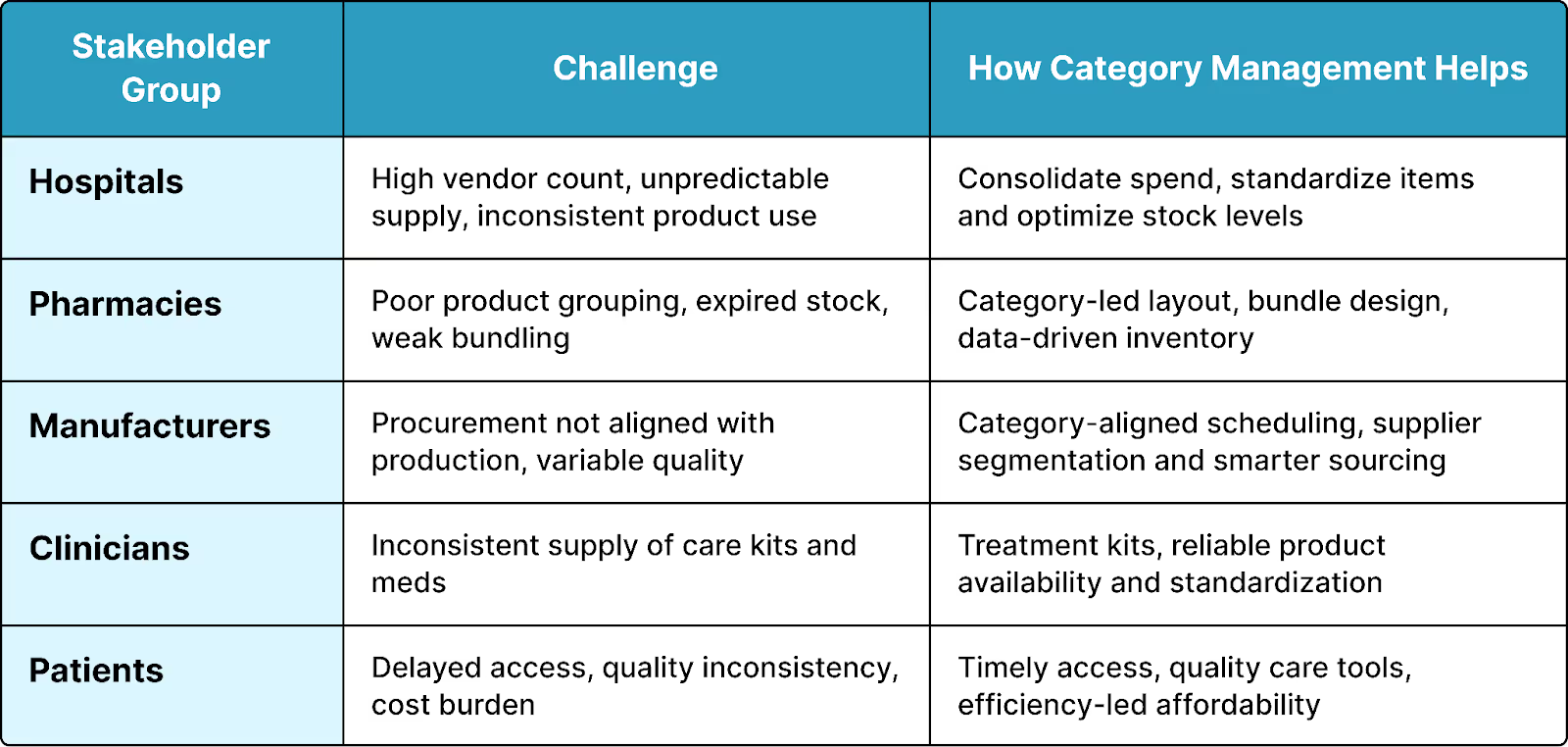
How Category Management Works in Pharma
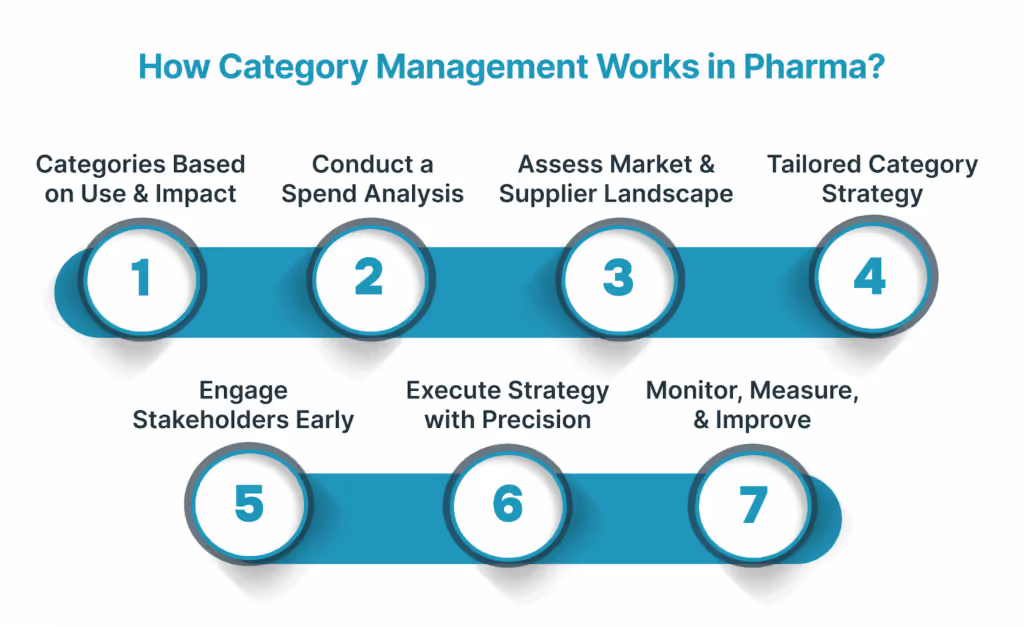
A modern pharmaceutical procurement strategy starts with structure. Implementing category management in pharma involves a series of well-defined steps that help segment spend, align supplier decisions, and drive results from supply chain optimization to better patient access.
Here’s how pharma organizations typically roll it out:
Step 1: Define Categories Based on Use and Impact
Start by grouping products and services based on logical, value-driven criteria. In pharma, this might include:
- Therapeutic areas (e.g., cardiovascular, oncology, diabetes)
- Usage context (e.g., inpatient vs. outpatient)
- Product types (e.g., generics, branded, biologics, OTC)
- Critical services (e.g., logistics, packaging, clinical trials)
This clarity helps assign strategic priorities to each group high-spend, high-risk, or innovation-focused categories.
Step 2: Conduct a Spend Analysis
Gather and analyze historical procurement and consumption data. Focus areas include:
- Top-spend categories and suppliers
- Underperforming product lines
- Volume trends, pricing variances, and stockout data
Tools like ERP systems or spend analytics platforms (e.g., SAP, Tableau) help visualize patterns and uncover inefficiencies.
Step 3: Assess Market and Supplier Landscape
Evaluate each category's external landscape to make informed sourcing decisions. Consider:
- Supplier performance history: delivery, compliance, responsiveness
- Market competitiveness: number of vendors, innovation pipeline
- Regulatory and ESG standing
Benchmark costs and quality standards to assess risks and opportunities.
Step 4: Develop Tailored Category Strategies
For each category, create a strategy that reflects its business and clinical importance. Define goals such as:
- Reducing total cost of ownership
- Improving supplier quality and innovation
- Ensuring availability of high-priority medicines or devices
- Enhancing speed to market for new therapies
Choose the right sourcing approach: long-term partnerships, dual sourcing, or bundling where relevant.
Step 5: Engage Internal Stakeholders Early
Collaboration is key. Bring together cross-functional stakeholders including:
- Procurement and supply chain teams
- R&D and clinical leads
- Regulatory, finance, and quality assurance
- End-users like pharmacists or department heads
Involve them in shaping strategies and reviewing category goals to ensure organizational alignment.
Step 6: Execute the Strategy with Tactical Precision
Turn strategy into action through:
- Strategic contract negotiation and supplier consolidation
- Introduction of bundled offerings (e.g., diabetic kits with devices + consumables)
- Inventory optimization and demand-aligned replenishment
- Integration with production planning and distribution models
Use APS tools like PlanetTogether for scheduling alignment, especially in manufacturing.
Step 7: Monitor, Measure, and Improve Continuously
Define and track relevant KPIs to assess success. This includes:
- Cost per treatment
- Supplier scorecards
- Stock availability and inventory turnover
- Quality metrics like Right-First-Time or CAPA effectiveness
Use analytics dashboards to review performance regularly and adjust strategies based on outcomes.
Platforms like AkiroLabs are built to support each of these steps helping pharma teams align strategy, data, and execution within a single framework.
STEP - BY - STEP CATEGORY MANAGEMENT ROADMAP (FLOWCHART)
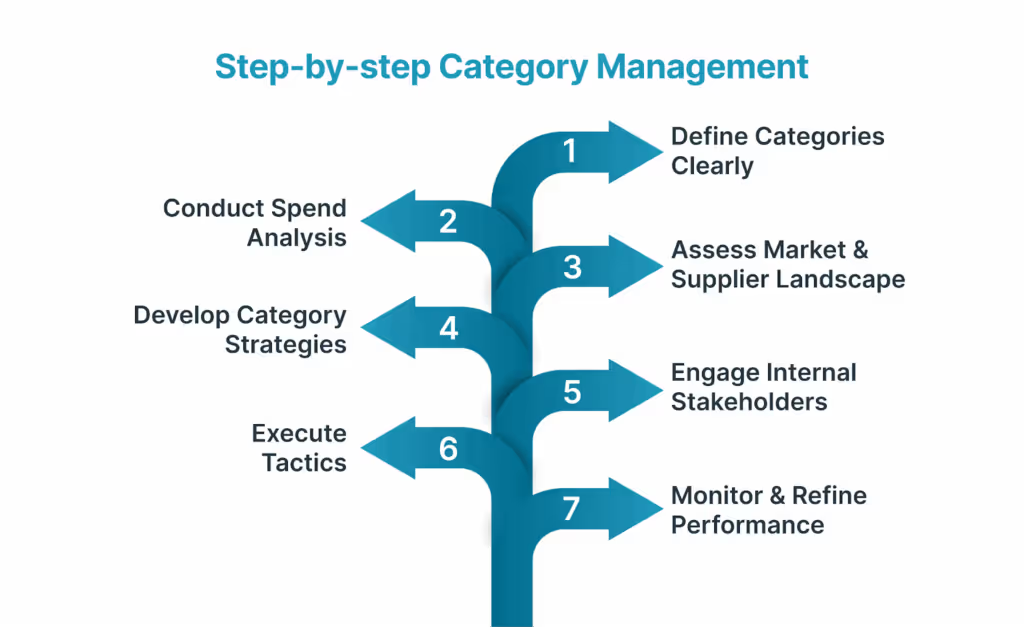
Step 1: Define Categories Clearly
Group products by therapeutic area, clinical use, or supplier type e.g., antibiotics, oncology, OTC drugs, or biologics.
Include related services like logistics, trials, or packaging if they impact category performance.Step 2: Conduct Spend Analysis
Use ERP or spend analytics tools to map historical data.
Identify high-spend areas, inefficiencies, and underperforming product lines.Step 3: Assess Market & Supplier Landscape
Evaluate supplier performance across cost, quality, lead time, innovation, and compliance.
Benchmark competitors, pricing, and sourcing options.Step 4: Develop Category Strategies
Set clear goals for each category cost control, availability, patient access, or risk reduction.
Tailor sourcing models to the product type (e.g., generics vs. branded).Step 5: Engage Internal Stakeholders
Align strategies with cross-functional teams (procurement, R&D, regulatory, operations).
Ensure all priorities are considered cost, clinical value, compliance, and timing.Step 6: Execute Tactics
Negotiate contracts, consolidate vendors, and implement bundled offerings (e.g., care kits).
Apply lean inventory and smart distribution planning.Step 7: Monitor & Refine Performance
Track KPIs like cost per treatment, supplier performance, and stock levels.
Adjust strategies regularly using feedback, market changes, and performance data.
KPIs in Category Management for Pharma
To know if your strategy is working, you must measure the right areas. In pharma procurement, performance extends beyond price—it’s about consistency, quality, and impact.
Case Study: Healthcare Client Using Structured Category Management
A healthcare provider was facing rising treatment costs and frequent supplier issues, especially in high-demand areas like oncology and diabetes. They introduced a formal category management in pharma program to segment categories, align internal teams, and measure performance and tracked results across key metrics.
Core KPIs in Category Management Pharma
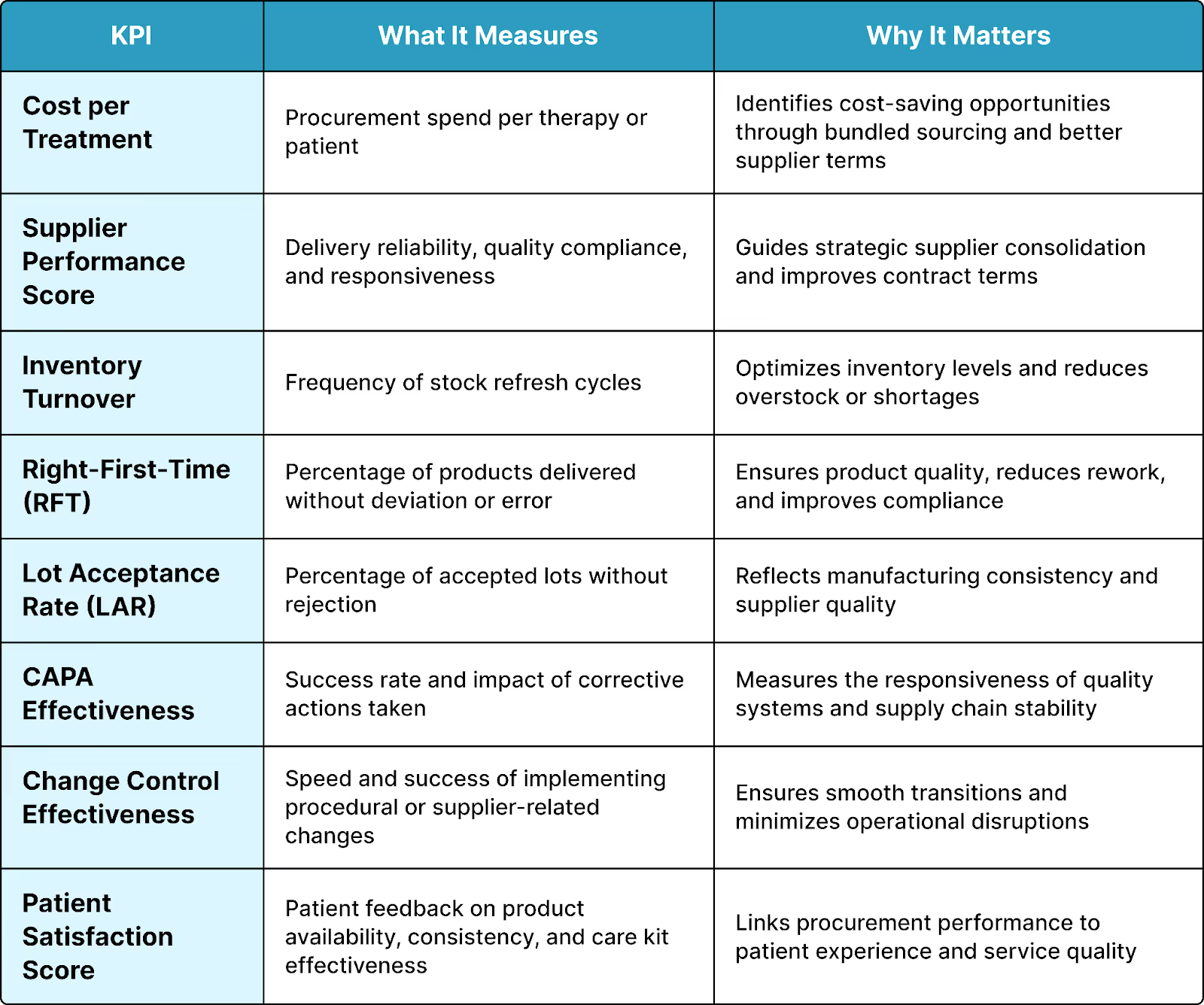
Results and Outcomes
Following category management implementation, the client saw:
- 18% reduction in cost per treatment
- 27% improvement in supplier on-time delivery
- Stock availability above 96% for priority items
- 21% rise in patient satisfaction through bundled care kits
These figures align with reported industry success in SpendEdge’s healthcare case study, demonstrating how category strategies improve performance and perception in pharma procurement
If you're ready to baseline your procurement strategy with measurable KPIs,
AkiroLabs offers dashboards and analytics to define, monitor, and respond to what matters most.
Request a demo today to see how your metrics can drive meaningful change.
Conclusion
Category management in pharma is a structured way to bring better control, consistency, and performance to procurement. It helps healthcare teams reduce costs, strengthen supplier terms, improve availability of medicines, and support patient care.
With the right steps—defining categories, analyzing spend, building strategies, and tracking KPIs—pharma organizations can turn procurement into a high-impact function.
If you're looking to apply these strategies across your categories, platforms like AkiroLabs can support every stage of the process.
FAQs
1. What is category management in the pharmaceutical industry?
Category management in pharma is a structured approach to segment products and services—such as drugs, medical devices, or therapies—into logical groups. Each category is managed with its own strategy to improve cost efficiency, supply reliability, and regulatory compliance.
2. What is the difference between procurement and category management?
Procurement focuses on sourcing and purchasing goods or services. Category management is broader—it includes strategy development, supplier segmentation, stakeholder alignment, and ongoing performance tracking for defined product categories.
3. How to set up category management?
Start by defining product categories, analyzing spend data, evaluating the supplier landscape, and developing strategies per category. Align stakeholders, implement sourcing tactics, and track KPIs for continuous improvement.
4. What is a category management strategy?
It’s a tailored plan to manage a specific product category—such as oncology drugs or diagnostics—based on its value, risk, and business goals. The strategy guides procurement decisions, supplier engagement, and performance tracking.
5. What is the first step in category management?
The first step is to define your categories. Group products or services by therapeutic area, product type, or supply characteristics. This sets the foundation for analysis, strategy, and execution.
What makes a successful pilot with akirolabs?
We define success collaboratively with your team. Typical outcomes include strategy creation for priority categories, measurable process improvements, and internal alignment. We provide full support and a clear roadmap for evaluation.
Can I try the platform hands-on after the demo?
Yes, we offer guided pilots and sandbox environments depending on your stage in the buying process. These give you and your team the opportunity to explore features in your own context.
Can I see how akirolabs would work with our specific categories?
Yes, we can tailor the demo to showcase how akirolabs works with your specific categories and procurement structure. Let us know your priority areas in advance, and we'll customize the demonstration accordingly.
Who should attend the demo from my organization?
We recommend including key stakeholders from your procurement leadership team, category management function, and procurement excellence or transformation groups. Including business stakeholders can also be valuable to demonstrate how the platform facilitates cross-functional collaboration.
How long does a typical demo take?
A standard demo takes approximately 45-60 minutes, allowing time for a comprehensive overview of the platform and discussion of your specific requirements. We can adjust the timing based on your availability and areas of interest.
What will I see during an akirolabs demo?
During the demo, you'll see the complete akirolabs Category Strategy Workbench in action, including the collaborative workflow, AI-powered insights from akiroAssist, strategic scenario modeling capabilities, and the Strategy One-Pager feature. We'll customize the demonstration to focus on aspects most relevant to your organization's needs.
Ready to Transform Your Procurement Strategy?
There’s a better way to do procurement. This is IT.
.avif)







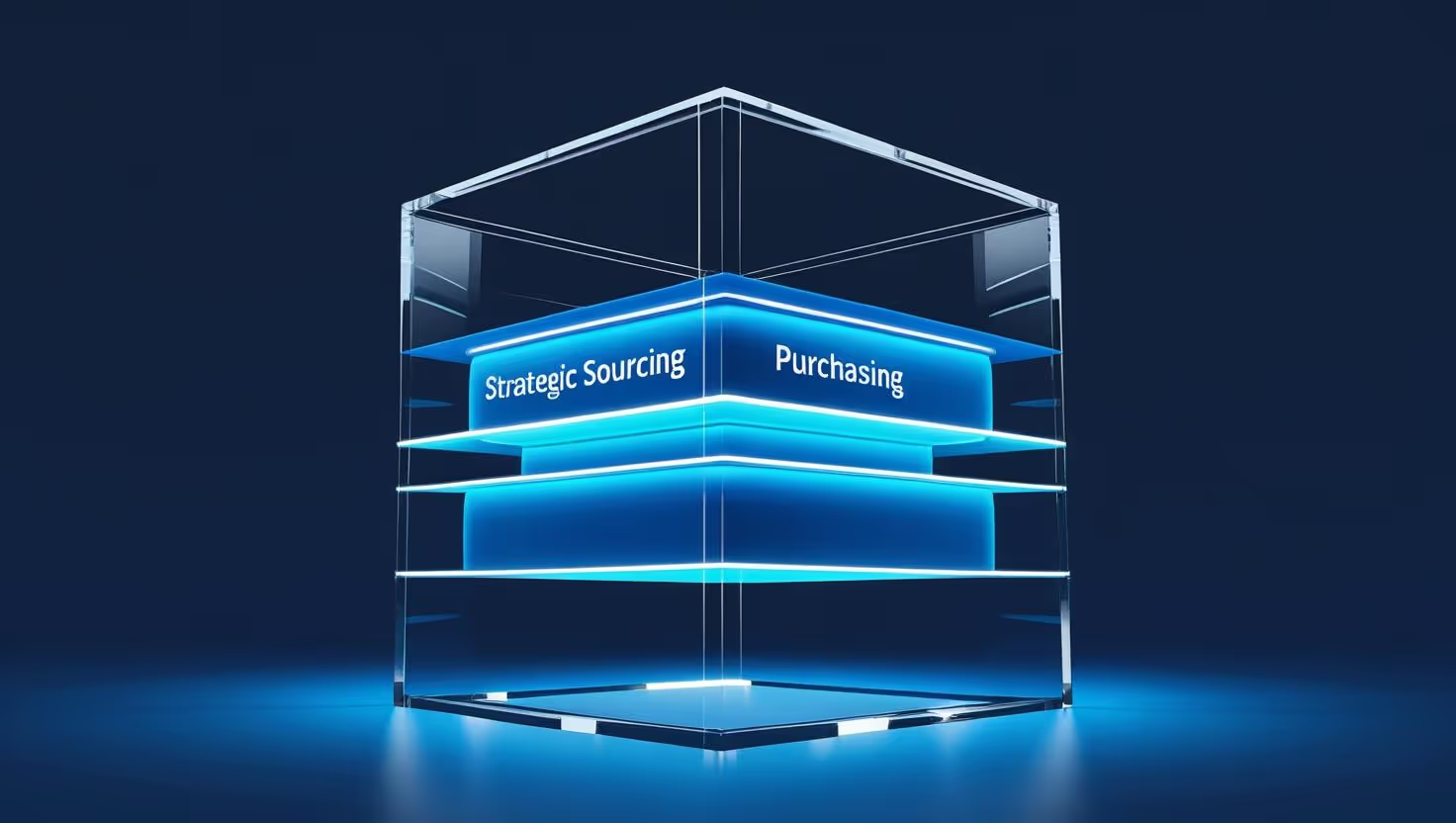

































































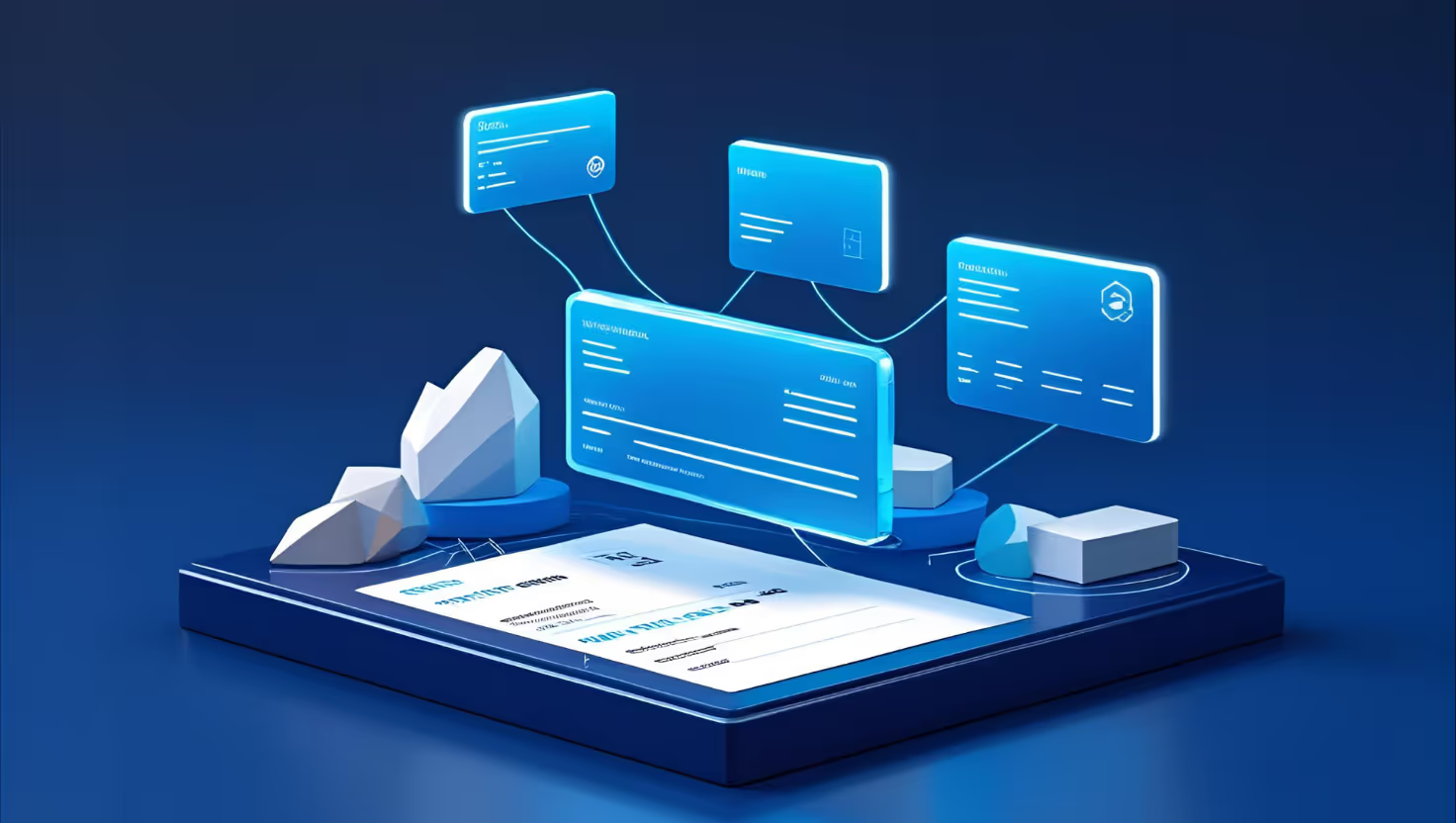



























.avif)







